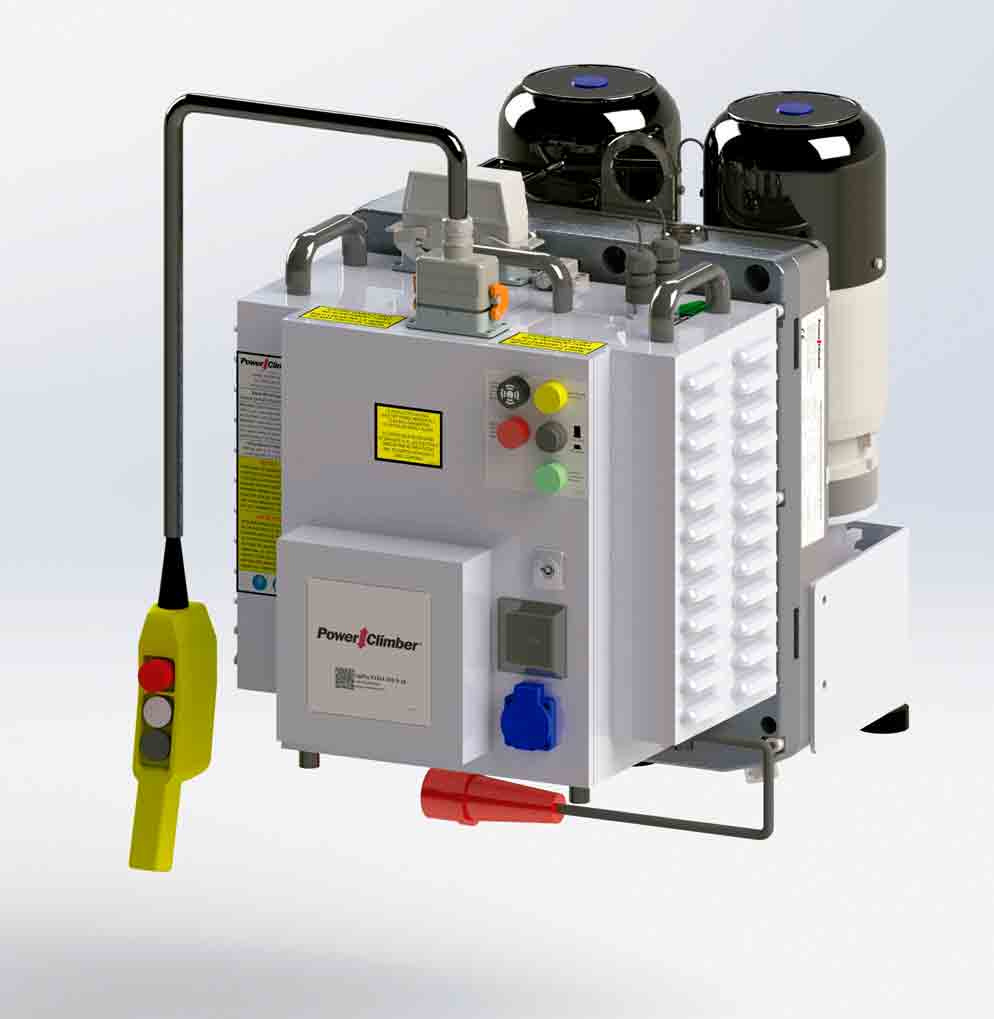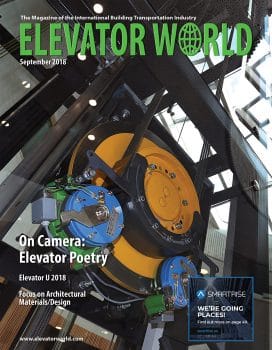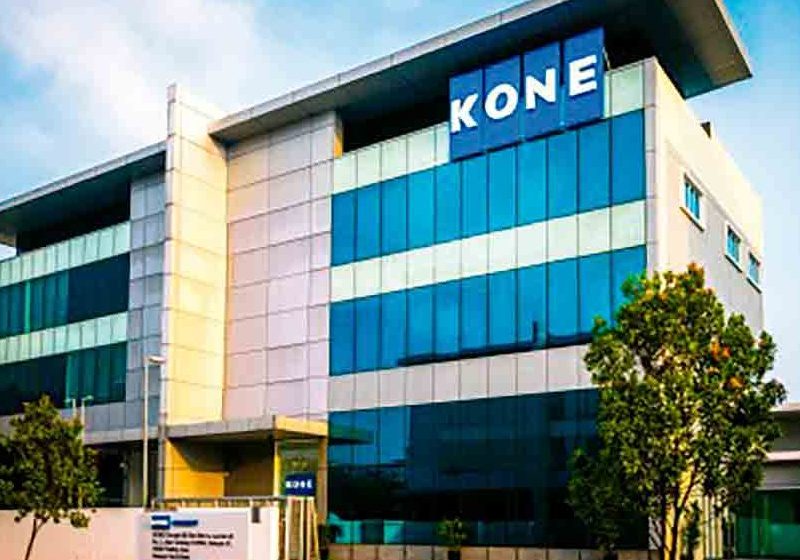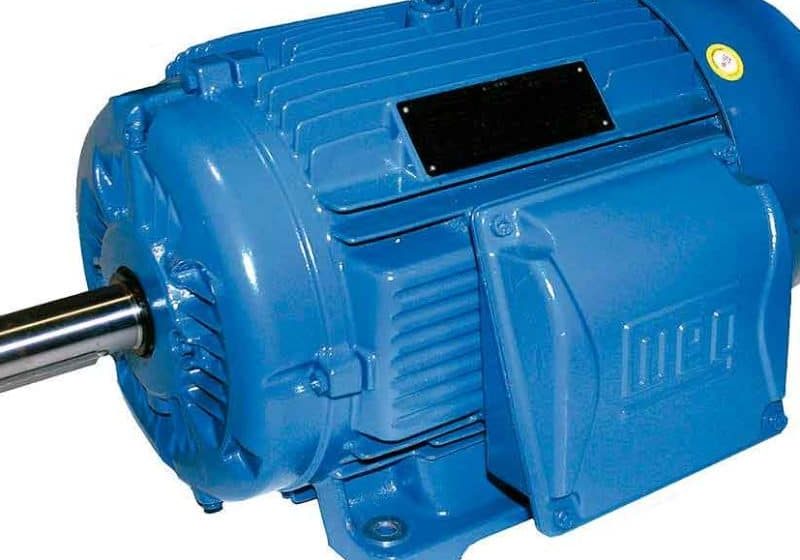A new hoist, compact cylinder and sensor join a simulator used to optimize building transportation.
High-Capacity Traction Hoist
Power Climber has added the UpPro P2514 VFD 5-18, what it calls “the highest-capacity man-riding traction hoist in the industry,” to its range of hoisting products. Able to lift 2500 kg, it can travel up to 18 mpm and incorporates electronics to optimize performance during elevator installations and modernizations. It can be connected directly to the car sling crosshead with a work surface to make a false car unnecessary. Double reeving is not required. Its variable-frequency drive enables it to run despite voltage drops or fluctuations, automatically adjusting the speed based upon power and load. If overloaded, it will notify the operator and self adjust to a lower speed, allowing work to continue.
Patent-pending configurability methodology moves the hoist from above the deck to below the work surface, freeing up the working area. Optional items include an overspeed safety lock and hoist car. The latter is custom made to reduce setup, installation and operation times. A CE-compliant version is available for European markets through Power Climber. For North American markets, Underwriters Laboratories-listed versions are available through Spider. Both allow for speeds up to 70 fpm in a guided application. Several guided-high- speed versions are available through Spider for these conditions.
Compact LDT for Hydraulic Cylinders
AMETEK Factory Automation has introduced a linear displacement transducer in a compact, rod-style package. The GEMCO® 958A Compact Housing LDT is less than 3.05 cm deep, making it appropriate for hydraulic cylinder applications where traditional rod-style transducers will not fit. The company says it is simpler to install and service than embedded-style sensors and has a variety of applications. Its 1,000-G shock resistance and 30-G vibration resistance promote long operating life in demanding applications. Made entirely from stainless steel, they are also designed for high accuracy, using 16-bit output resolution for reliable, absolute analog position feedback accurate to 0.04% of the programmable sensing distance.
www.AmetekFactoryAutomation.com
Energy-Saving Escalator Detection Sensor
CEDES’ TOF/Start sensor is designed to save up to six times more energy than regular escalator detection sensors. Using CEDES’ Time of Flight (TOF) technology to distinguish if a person is walking through the sensor’s detection zone is actually walking toward the escalator to use it or simply passing by, the product can increase energy savings by as much as 600%. A total of 12 hr. more “slow mode” across only two escalators saves approximately 50 kWh savings per day, estimated at US$1,500, the company said. This is because it can greatly increase the “slow mode” of an escalator, which uses 2.5 kW, versus 7.5 kW when the escalator is in normal mode.
In a case study in a Swiss shopping center, the direction- recognition feature increased slow-mode usage from 1 to 6 hr. per elevator per day. Schindler Master Escalator Instructor René Würsch, who chose the product for the project, explained:
“The TOF/Start is a great solution, because we can set the detection area to match the individual application’s needs. You can make it as big or as small as you want and know that cross-traffic will be ignored. There are huge energy savings to be made. The TOF/Start is also easy to install, particularly if you are using the cabling of existing sensors. It took about 1 hr. per TOF/Start, so, with four sensors it took four hours. This is a very reasonable downtime for such major savings down the road.”
cedes.com/en/products/tof-start
Simulator Aggregates Building Movement Data
EIT Digital has released a simulator called Virtual Building Service, which creates digital replicas of a building to, for example, help find transportation bottlenecks within it. Part of the company’s Digital Industry Action Line, it is intended to make it easier for developers, owners and architects to use realistic digital simulation to test and optimize people flow and building occupancy. KONE and IBM are two partners in what the company called an “initiative,” with the former acting both as business owner and activity leader.
Simulation data is collected in real time by sensors or, in the case of a new facility, from previous studies and research. KONE’s Head of People Flow Optimization Juha-Matti Kuusinen explained:
“Our simulation capability is much improved. We can, for example, simulate people flow in the lobby of an office building — understand how that might look along with the waiting times for the elevators. Not only can we calculate a building’s efficiency, but we can also benchmark it with similar buildings and conclude if the building is performing very well or if there’s room for improvement.”
Combining both the horizontal and vertical dimensions, the simulator can be connected to sensors providing real-time data about the building’s condition, creating a “digital twin” against which to compare the real-life version. KONE intends to use this feature to test new services that will be offered across a building’s lifecycle.
Get more of Elevator World. Sign up for our free e-newsletter.









